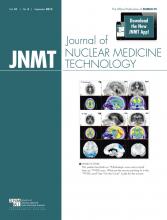TO THE EDITOR: Nuclear medicine has come a long way in the reduction of nosocomial infections, but the truth is that there is still more we can do as a community to better ensure the safety of our patients. When we think of precautions within the nuclear medicine field, hand washing, sterilization of imaging equipment, and USP <797> are all things that come to mind. All are essential in reducing nosocomial infections; however, we as a community have not considered some of the other critical equipment involved in our daily care as technologists: syringe shields, lead-lined carrying cases, and lead-lined syringe holders. These items are in constant use in all procedures, and it is these items that need policies in place to ensure that our patients are adequately protected. Without policies and guidelines for the proper cleaning of these items, there can be no guarantee that our patients are protected or that these items are being sterilized effectively.
Every hospital and institution has a policy in place about dealing with contact-isolation patients. We clean the equipment, the camera, and anything else with which the patient comes into contact. One thing we may overlook is the equipment we use in injecting these patients: the syringe shield that we touch when injecting the patient and the syringe holder to which we return the syringe shield. In the wrong situation, whether through lack of knowledge or poor management, this situation can potentially compromise the safety of our patients. Let’s consider the situation of a patient undergoing lymphoscintigraphy in the operating room. As we all know, our operating rooms are sterile environments. Doctors scrub before entering. What about the equipment we bring into that environment? Are the same considerations taken? How can we ensure this equipment is cleaned just as effectively as any other equipment brought into the operating room? As technologists, we have an obligation to our patients to ensure that not only the dose we provide our patients but also the equipment in which it is encased is sterile. The nuclear hot lab is another environment that is meant to be sterile. How can we bring nonsterile equipment into this environment, store it there, and continue to call the environment sterile? Most nuclear medicine departments clean these items, but without any universal practices how can we assure our patients that we are cleaning these items effectively? When doing an in vitro multiple gated acquisition scan, we draw blood from the patient that is used to produce a kit (following the guidelines of the manufacturer). That blood could have accidentally come into contact with our equipment. What if there are no policies in place and the technologists forego cleaning the syringe shield because they are in a hurry? Since there are no policies and guidelines in place to ensure that the technologists clean the equipment, can they be held accountable?
I recently spoke to a colleague in a neighboring hospital. During an internal inspection, the infection control team brought up the issue of who is responsible for cleaning these items. The truth is that there are no policies in place. Because the equipment we use comes into indirect contact with many patients, it is easy to understand how this equipment can be overlooked as seemingly harmless to the public, but we as technologists and potential patients know and demand better. The fact of the matter is that it comes into contact with all our patients. The truth is that I have never heard of repercussions for not cleaning the equipment we use.
Nuclear medicine is part of a team that diagnoses and treats patients. We have a common goal to do what is best for the patient. That being said, fighting nosocomial infections and addressing cleanliness issues is our responsibility. The Centers for Disease Control has stated that nosocomial infections are a leading cause of death in the United States and that, according to a recent study, 1% of lead pigs using disposable inserts are delivered with blood-contaminated inserts. We owe it to our patients to give them the best care we can. These items are cleaned in nuclear medicine departments, but with what efficacy? How often? We need a universal policy to ensure that the equipment is cleaned in a manner deemed effective.
Footnotes
Published online Jun. 26, 2013.







